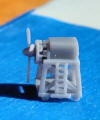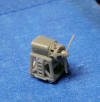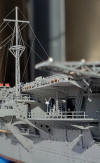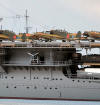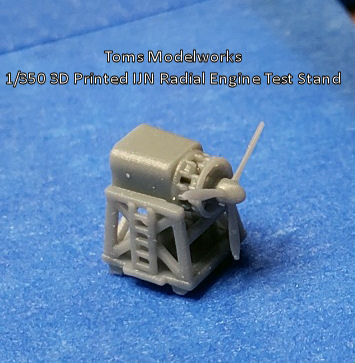
|
|||||||||
|
|||||||||
| BACKGROUND | |||||||||
| Throughout the 1920s and 1930s, shipboard maintenance of aircraft engines became routine aboard aircraft carriers. As a matter of expediency, the Imperial Japanese Navy found it necessary to test its (radial) aircraft engines after repair in a manner that did not require prior installation in an air frame. It developed a mobile test stand that could hold a radial engine, propeller, and fuel while allowing the stand to be moved along a trolley rail to an open area outside a portion of the hangar deck devoted to engine repair. Often, this area was located on a sponson or extended decking at the aft end of the hangar deck on the portside of the hull. | |||||||||

Click to enlarge images |
|||||||||
| REVIEW SAMPLE | |||||||||
| Actual documentation of this apparatus
is virtually non-existent in the factual record. Ships plans document the
existence of the engine test stand area and the trolley rails, while photos
confirm the existence of roll-up steel doors to the engine test compartments.
However, there exists no information whatsoever on the actual test stands.
Sources in Japan confirm this lack of documentation.
In the absence of such information, modelers have been left to their own imagination as to the shape and size of this type stand. Over time, I have taken note of the various configurations worked up by certain modelers, particularly those in Japan. For the most part, they seem to follow the same design, generally using an A-frame like stand, set on trolley wheels much like the aircraft trolleys used by Japanese ship-borne float planes. I had scratch-built a similar design for several of my 1-700 builds in the past, but wondered if this could be something rendered in 1/350 by 3D printing. I contacted Tomís Modelworks to see if this was a challenge that they might by interested in. In short, yes. So, I fed their resident 3D printing guru, Alex Harden, several of the likely test stand iterations as well as information on the Nakajima Sakai-12 radial engine that powered both the Mitsubishi A6M Zero Fighter and the Nakajima B5N Kate Attack bomber. In this scale, the basic layout of the Sakae engine would suffice to represent any number of radial engines. In turn, Alex quickly turned out a beautiful engine test stand prototype, complete with engine, mounting bulkhead/fuel tank and ladder access. Just a few tweaks were needed for proper scaling of the stand and propeller. |
|||||||||
|
|||||||||
| CONCLUSIONS | |||||||||
| The results speak for themselves.
Highly recommended.
This item is now available on Tomís website as SKU # P719. Unit cost is US $5.00. The sample was courtesy of Tomís Modelworks. (For the record, I have no commercial interest in this item.) |
 |
||||||||
